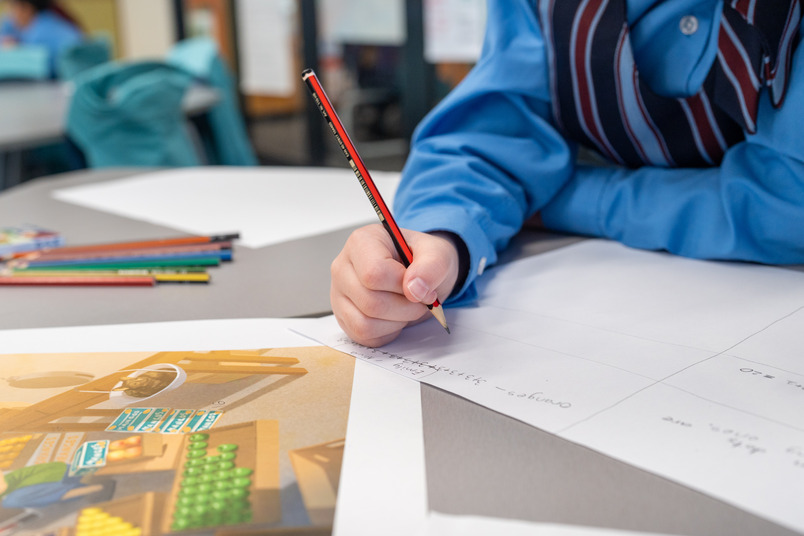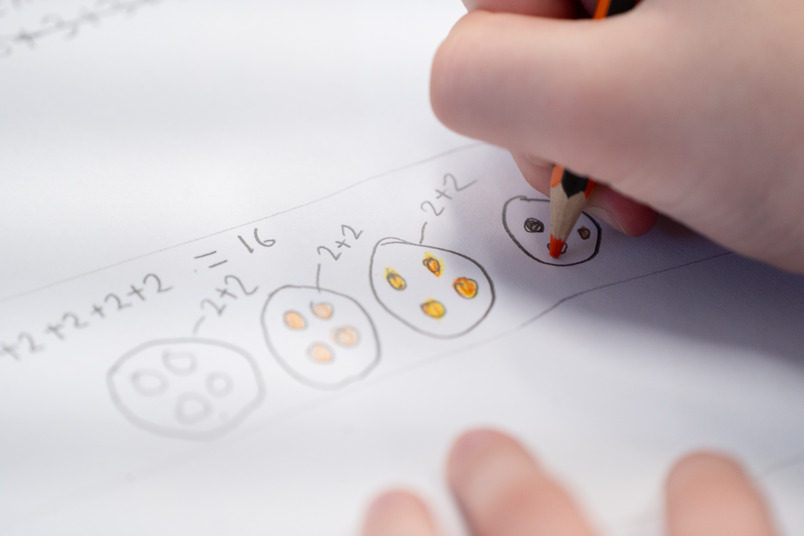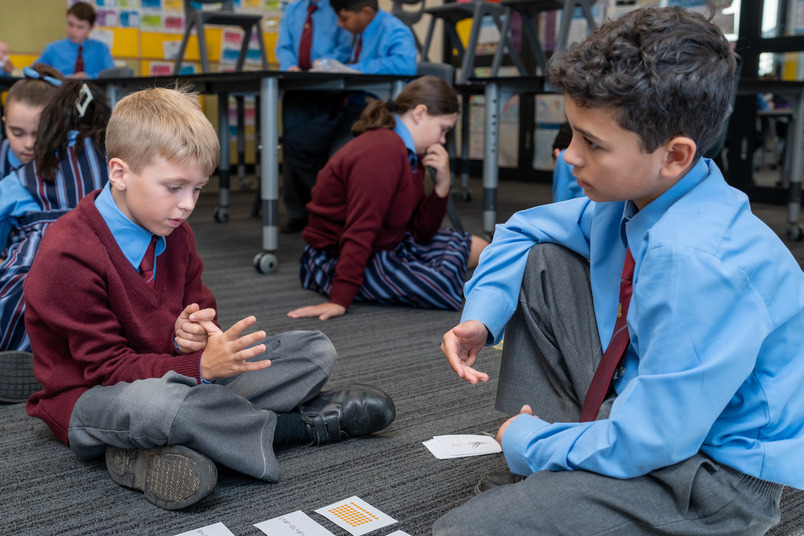Multiplication: reSolve Market
View Sequence overviewMultiplication is about coordinating two ideas: how many groups and how much in each group.
Whole class
reSolve Market PowerPoint
Each group
Counters
reSolve Market picture printed on A3
Each student
Blank A3 paper
Post-it notes for the gallery walk
Task
Use reSolve Market PowerPoint to introduce the context of the reSolve Market.
Show students slide 3 which displays the illustration of the reSolve Market.
Discuss as a class: What do you notice? Some examples of multiplication represented in the picture include:
- equal-sized groups as bags of fruit
- boxes of fruit arranged into arrays of a number of rows, each of an equal quantity
- the price per kilo, or for each bag/punnet
Pose the task: I can see a lot of multiplication in this picture! What multiplication do you see?
Ask students to work in pairs. Provide each pair with reSolve Market picture, access to counters to use if they choose, and a blank A3 sheet of paper.
Ask students to create a poster on their A3 paper of all the multiplication that they see on reSolve Market picture. Allow students time to represent their thinking in any way they choose.
Students will see multiplication in a range of ways. The purpose at this early stage in the sequence is to take note of what students see as multiplication in the illustration.
- Do students recognise multiplication as repeated, equal-sized groups?
- If students work out the total number of fruit in different displays, do they use strategies such as skip counting and repeated addition to work out the total?
- Do they link multiplication facts to any examples of multiplication that they see?
This task serves as a helpful pre-assessment task. The strategies that students’ use will indicate their existing understandings of multiplication. Pose questions or prompts that help you to make sense of student thinking. For example:
- Explain why this is an example of multiplication.
- Can you see any examples of things that do not represent multiplication?
- The plants and the tins are not representations of multiplication. The garlic is partially hidden so we cannot confidently say that it represents multiplication either.
Multiplication in the reSolve Market

There are different types of multiplication problems: equal groups, Cartesian product, and scaling. This sequence focuses on the idea of equal groups.
Some examples of equal groups in the reSolve Market picture include:
- equal-sized groups e.g. 3 bags each with 5 pears
- multiplicative comparison/rates e.g. twice as many blueberries as raspberries
- rectangular arrays e.g. 4 rows of 5 oranges
You can use this task as a formative assessment of students’ existing understanding of multiplication. Students are invited to ‘notice’ multiplication in the reSolve Market picture. The picture places emphasis on equal-sized groups and arrays, although some may notice the examples of multiplicative comparison/rates.
The teacher’s role is to notice students’ thinking and understanding and some of the strategies they may use.
There are different types of multiplication problems: equal groups, Cartesian product, and scaling. This sequence focuses on the idea of equal groups.
Some examples of equal groups in the reSolve Market picture include:
- equal-sized groups e.g. 3 bags each with 5 pears
- multiplicative comparison/rates e.g. twice as many blueberries as raspberries
- rectangular arrays e.g. 4 rows of 5 oranges
You can use this task as a formative assessment of students’ existing understanding of multiplication. Students are invited to ‘notice’ multiplication in the reSolve Market picture. The picture places emphasis on equal-sized groups and arrays, although some may notice the examples of multiplicative comparison/rates.
The teacher’s role is to notice students’ thinking and understanding and some of the strategies they may use.
Display students’ work in preparation for the gallery walk.
Review the task that was posed and ask students to think about what they expect to see as they complete the gallery walk. Ask students to consider the following questions as they look at others’ work:
- What multiplication have others noticed in the reSolve Market picture? Why is this an example of multiplication?
- Is there anything that surprises you?
Provide students with post-it notes for them to write questions and comments on other students’ work.
Conduct the class gallery walk.
At the end of the class gallery walk, allow students time to read and reflect on any post-it notes left on their work, and to adjust or change to their poster as needed.
The role of the student

In a gallery walk the role of the student is to critically view and review others’ mathematical activity. They need to think more broadly than the strategy they have personally used, as they consider how their thinking fits with the representations of thinking used by others in the class.
In this gallery walk, students are asked to look at how others have solved the problem and consider which strategies are the most helpful when determining the total number of cakes in the array. As students look at others’ strategies, they are able to reflect on and refine their own approach to solving the problem.
At the end of the gallery walk students should be given time to read and reflect on the sticky notes that have been left for them. Students should be allowed time to modify their work if they would like to. The questions and feedback on these notes will help refine students’ thinking and the manner of their mathematical recording. It is also likely that the students will have developed new thinking as they critically viewed and reflected on others’ work, and it is important that students have the opportunity to act on this new learning.
In a gallery walk the role of the student is to critically view and review others’ mathematical activity. They need to think more broadly than the strategy they have personally used, as they consider how their thinking fits with the representations of thinking used by others in the class.
In this gallery walk, students are asked to look at how others have solved the problem and consider which strategies are the most helpful when determining the total number of cakes in the array. As students look at others’ strategies, they are able to reflect on and refine their own approach to solving the problem.
At the end of the gallery walk students should be given time to read and reflect on the sticky notes that have been left for them. Students should be allowed time to modify their work if they would like to. The questions and feedback on these notes will help refine students’ thinking and the manner of their mathematical recording. It is also likely that the students will have developed new thinking as they critically viewed and reflected on others’ work, and it is important that students have the opportunity to act on this new learning.
This class discussion focuses on multiplication as how many and how much, that is how many groups and how much in each group.
Use the illustration on slide 3 of the reSolve Market PowerPoint to support the discussion.
Select some students to present their posters to the class. Ask students to share the different examples of multiplication that they found and why they believe they are examples of multiplication.
Discuss:
- What was similar about all the multiplication we noticed?
- The use of equal-sized groups or equal rows and columns will be the same for these examples of multiplication.
Show slide 4. This emphasises the ‘how many groups’ and ‘how much in each group’ structure of multiplication.
How many and how much

Multiplication involves students recognising and working with three quantities:
- how many groups
- how much in each group
- the whole
Students’ initial experiences with numbers focus on counting how many, where they count in a unitary way, and only keep track of the count. Multiplication is more complex, as students have to keep track of two things simultaneously:
- how many groups
- how much in each group
This involves using a binary count. The double count can be made explicit for students by the teacher using a numeral to record how many and a word when you record how much. For example, when you refer to 4 bags of 6 lemons, you would record this as 4 sixes, to show the distinction between the two counts.
When students record their thinking as a multiplication fact, it can be helpful to understand multiplication as the process which finds ‘how many of how much to give the product’. This can be written as:
$$\text{how many} \times \text{how much} = \text{the whole}$$
Multiplication involves students recognising and working with three quantities:
- how many groups
- how much in each group
- the whole
Students’ initial experiences with numbers focus on counting how many, where they count in a unitary way, and only keep track of the count. Multiplication is more complex, as students have to keep track of two things simultaneously:
- how many groups
- how much in each group
This involves using a binary count. The double count can be made explicit for students by the teacher using a numeral to record how many and a word when you record how much. For example, when you refer to 4 bags of 6 lemons, you would record this as 4 sixes, to show the distinction between the two counts.
When students record their thinking as a multiplication fact, it can be helpful to understand multiplication as the process which finds ‘how many of how much to give the product’. This can be written as:
$$\text{how many} \times \text{how much} = \text{the whole}$$
Explain: Multiplication is based on equal-sized groups. These might be represented as groups or as an array in rows and columns. In multiplication, we need to work out two things: ‘how many groups’ and ‘how much in each group’.
Show slide 3 of the reSolve Market PowerPoint again. Look at some of the different examples of multiplication and discuss how many groups there are and how much is in each group.
Create a class display using the students' posters, using the summary statement from above as a title for the display. Read the Class display professional learning embedded in this step to learn how this display can be used to build a shared understanding amongst the students.
Class display

In the Summarise phase, the following statement is presented to students:
Multiplication is based on equal-sized groups. These might be represented as groups or as an array in rows and columns. In multiplication, we need to work out two things: ‘how many groups’ and ‘how much in each group’.
This statement reflects the learning goal for the task and is the understanding that we want all in the class to share. As the sequence progresses, this shared understanding is built on.
Create a banner or poster of this shared understanding and display the students’ posters of solutions strategies underneath or around the shared understanding. This provides the opportunity for students to revisit and reflect on this understanding and the ways that that it is reflected in the different solutions strategies used by students. The display is a way to help ensure the understanding is truly shared by all in the class.
Presenting everyone’s work with this statement communicates that everyone has contributed to and participated in developing this understanding as shared in the class, regardless of how complex or sophisticated their thinking may or may not be.
In the Summarise phase, the following statement is presented to students:
Multiplication is based on equal-sized groups. These might be represented as groups or as an array in rows and columns. In multiplication, we need to work out two things: ‘how many groups’ and ‘how much in each group’.
This statement reflects the learning goal for the task and is the understanding that we want all in the class to share. As the sequence progresses, this shared understanding is built on.
Create a banner or poster of this shared understanding and display the students’ posters of solutions strategies underneath or around the shared understanding. This provides the opportunity for students to revisit and reflect on this understanding and the ways that that it is reflected in the different solutions strategies used by students. The display is a way to help ensure the understanding is truly shared by all in the class.
Presenting everyone’s work with this statement communicates that everyone has contributed to and participated in developing this understanding as shared in the class, regardless of how complex or sophisticated their thinking may or may not be.